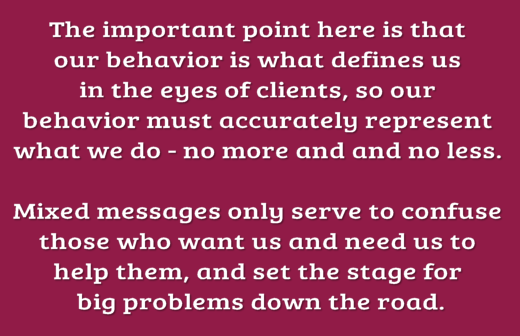A few weeks ago, I wrote Fool Me Once, Shame on You, But Fool Me Twice about the problems that can hurt patient-clients which also hurt our profession because they violate our ethical principles and best practices. Those problems range from advocates working beyond their own abilities to help clients because they may not have the experience or education to do so, to selling medical products on their websites, and others.
Today we’re looking at the promised Example #2 of this problem in hopes of a hard stop. That problem: the danger of mixed messages.
As stated in the Fool Me Once post,
I fully expect that some of you will be appalled, possibly upset with me, because you’ve not thought of these as violations or misrepresentations. Some of you innocently don’t realize these transgressions; but now, as of reading this post, you are on notice…. please look at this not as judgment, but as a time for correction.
Mixed Messages
Sometimes our words and behavior – vs – what we as private patient advocates can do ethically, even legally, are in conflict. Sometimes subtle, sometimes more blatant, it’s those mixed messages that will cause an advocate to be sued one day and, frankly, it will be his or her own fault because it is easily preventable. Further, when that advocate is sued, his or her liability insurance, which is purchased specifically to pay for legal assistance, will look at these mixed messages and refuse to provide that cost support for legal needs.
What’s that lawsuit-provoking mixed message?
Patient advocacy is not medical. And yet, you could never prove that by the behavior and marketing materials of too many advocates.
We’ll begin with photographic images that say one thing when something else is true. Nurses are the biggest perpetrators of this problem, although it’s not limited to them.
I call it stethoscope-itis.
That is – the photography found on many advocates’ websites, many brochures, even some business cards, which shows someone with a stethoscope, or using a blood pressure cuff, or holding a thermometer, or wearing a nurses uniform or white medical coat, or even just an image of a medical tool itself – images that visually and loudly proclaim “I provide medical services!”

Granted, many advocates had clinical careers in past lives, and that can be a solid basis for their non-medical advocacy work. They understand terminology, they understand anatomy and body systems, they understand disease and treatment processes. That understanding can certainly lend itself to excellence as a non-medical advocacy career. Their knowledge and experience will be invaluable to clients.
But using medical imagery to promote non-medical services is a distinct line that should not be crossed.
Behavior Speaks Louder Than Words
And then, I hear stories about doctors and nurses who call themselves patient advocates, but who begin their interface with their clients by taking vital signs. That’s hands-on medical work. At the least it’s confusing for clients. At the most, for those medical professionals who no longer maintain their licenses, it may be against the law. In all cases, it is opposed to any patient advocacy insurance they hold and patient advocate ethics they have signed on to.
It may also prevent them from becoming certified patient advocates. The non-medical service model is very clearly outlined and defined in all the existing codes of ethics and professional standards, and is firmly described in the documents and decisions provided by the Patient Advocate Certification Board. Such behavior may get in the way of that advocate being certified by the PACB.
If this upsets you or if you think I’m wrong, then here’s a metaphor to help you better understand why this is so important:
Suppose you need a new computer. You don’t really understand how computers work, but you know how to use one and why you need one. You go online and see lots of great pictures of computers, you go to an electronics big-box store and see them all lined up, one after the next, you try out a few, and they all seem to do what you want them to do. Finally you buy one at that big-box store, take it home, plug it in, and begin using it. You write, and print out some letters, you play a few games, you try to send an email… but it won’t send. What? The computer seems to work just fine, but you just cannot get it to send an email. So you decide to call that big-box store to ask for help when you discover you can’t get to the internet to look up the phone number. What? Finally, in frustration, you put the computer back in the box and take it back to the store.
“Oh – so sorry you’re having trouble!” they tell you. “But the computer you bought wasn’t built to be used for the internet; it’s only built to help you write letters, create spreadsheets and play games. If you wanted an internet computer, that’s what you should have bought!”
How frustrating and upsetting would that be? It never occurred to you to ask whether it was an internet computer because – well – you assumed ALL computers were internet computers, and the computer you purchased looked no different than what you already knew to be true – computers can be used on the internet, right>? Even if the store lets you return the computer and get your money back, they wasted your time, they made you feel stupid, and now you can’t trust them. Further, it’s not just that one store you can’t trust – it’s all the stores in that big-box chain.
THAT is how some patient-clients will feel about the medical professionals they hire to be their advocates. The photos on an advocate’s website are medical photos. They see RN and MD next to the advocate’s name. They thought ALL nurses and doctors provided medical services! No, they didn’t read the site carefully. They didn’t need to! The nurse looks so friendly and capable, and after all – she has a stethoscope around her neck….
Unless the fact that you CANNOT AND WILL NOT be working in a medical capacity is front and center and clear in every interface with you, consistently, potential clients will assume you provide medical services.
Logically, then, any advocate who mixes those messages, who blurs those lines, could be creating havoc for themselves (those aforementioned lawsuits) and for our profession.
If confused patient-clients think their expectations have been violated, they will seek remedy. We can’t remedy something we can’t justify.
Now – in anticipation of all you doctors and nurses who proclaim, “But wait a minute! My training and experience are needed! Relevant! Important!” – to that I say – Yes! Of course they are!
And I am not suggesting for a moment that you discount them in any way. In fact, providing information to people about your education and experience is an important aspect of your marketing and your service!
You need to make it clear that medical isn’t WHAT you do; it’s what gives you the ability to be GOOD at what you do.
A subtle difference, perhaps, but it will make all the difference in the future of your practice.
When your website and marketing materials suffer from stethoscope-itis, when they are peppered with medical-uniformed people, holding medical tools (whether or not they are stock photos or real photos of you); when you show up with a stethoscope around your neck or begin by checking someone’s pulse or blood pressure, then it doesn’t matter what your words say. Your images and behavior say you provide medical services. Your picture and behavior are screaming a thousand words that aren’t supposed to be true.

The important point here is that our behavior is what defines us in the eyes of clients, so our behavior must accurately represent what we do – no more and and no less. Mixed messages only serve to confuse those who want us and need us to help them, and set the stage for big problems down the road.
Please take a moment to examine the messages YOU are sending. If you decide there could be some confusion, then do what is necessary to clear them up. You owe it to yourself, you owe it to the profession, and most of all, you owe it to the people who will need you, and who won’t have the where-with-all to try to sort out confusing messages when they need an advocate.
LEARN ABOUT APHA MEMBERSHIP | FIND MORE REASONS PATIENTS NEED ADVOCATES?






Thank you. As a physician who has carefully and painstakingly made this clear to clients in every single encounter, marketing tool, speaking engagement etc., I appreciate this distinction being underscored. I have worked diligently to separate myself from the “practice” of medicine so that my clients, not patients, can benefit from the expertise I can afford them in my position as an advocate. The knowledge base may be essentially the same, but my role in healthcare has clearly been re-defined by my choosing. I chose to “hang up my stethoscope ” and assume a new role as health advocate. Anyone blurring those lines within their advocacy practice is essentially undermining the very distinction the rest of us are trying to uphold.
Could not agree more! I have had real struggles with my marketing company, as they wanted to use pictures of medical personnel, the word “patient” as opposed to client and a litany of other danger-words.
I use a Welcome Letter for my clients that is crystal clear what are and are not. They sign and date the letter and it is binding.
Here is the verbiage of a key paragraph, if anyone would like to use something similar.
“While our navigators are often physicians, nurses and other licensed health care providers, their role is to help you navigate the health care system and to help you understand and access your treatment options. We do not provide healthcare services and as such we are not responsible for healthcare outcomes. We work to require your healthcare providers to give you the respect you deserve and to communicate clearly and directly with you about your health conditions and treatment. None of our services are covered by private health insurance or governmental health plans such as Medicare. We do not participate as providers in any such plans, because we are not health care providers. These health plans will not pay for or reimburse you for the services that we provide because they are not healthcare services.”
Thank you for this incredibly important reminder!